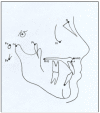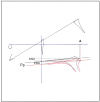Cranial base and maxillary changes in patients treated with Frankel' s functional regulator (1b)
- PMID: 22322486
- PMCID: PMC3476035
- DOI: 10.4317/medoral.17631
Cranial base and maxillary changes in patients treated with Frankel' s functional regulator (1b)
Abstract
Objectives: The purpose of this study was to assess cranial base and maxillary growth in patients with Class II-type I malocclusions when treated with Frankel' s functional regulator (FR-1b).
Study design: The treatment group was made up of 43 patients that were divided into two groups: prepubescent (n: 28), and pubescent (n: 15). The control group included 40 patients who did not receive any kind of treatment and were likewise divided into a prepubescent group (n: 19), and a pubescent group (n: 21). A computerized cephalometric study was carried out and superimpositions were done in order to assess the antero-posterior, vertical and rotational movement of the maxilla.
Results: The results indicate that anterior cranial length is not affected by the regulator but the cranial deflection of the treatment group was diminished. Although a slight counterclockwise rotation effect on the upper jaw was observed due to treatment, no growth restriction of the maxilla in a vertical or antero-posterior direction was observed compared to other non-treated Class II-type I malocclusion patients.
Conclusion: The functional regulator does not have any effect on anterior cranial length, but it does affect the angulation of the cranial base. According to our results, the appliance has demonstrated a flattening effect of the cranial base (p<0.05) in the treated sample. The functional regulator induces counterclockwise rotation rather than vertical or sagittal changes in the maxilla.
Figures


Similar articles
-
[An eight-factor analysis of early skeletal Class II malocclusion using Fränkel appliance].Hua Xi Kou Qiang Yi Xue Za Zhi. 1999 Aug;17(3):271-4. Hua Xi Kou Qiang Yi Xue Za Zhi. 1999. PMID: 12539305 Chinese.
-
Effects on the maxilla and cranial base caused by cervical headgear: a longitudinal study.Med Oral Patol Oral Cir Bucal. 2012 Sep 1;17(5):e845-51. doi: 10.4317/medoral.17698. Med Oral Patol Oral Cir Bucal. 2012. PMID: 22322499 Free PMC article.
-
Study of mandibular growth in patients treated with Fränkel's functional regulator (1b).Med Oral Patol Oral Cir Bucal. 2012 Sep 1;17(5):e884-92. doi: 10.4317/medoral.17958. Med Oral Patol Oral Cir Bucal. 2012. PMID: 22549680 Free PMC article.
-
Three-dimensional diagnosis and management of Class II malocclusion in the mixed dentition.Semin Orthod. 1996 Jun;2(2):114-37. doi: 10.1016/s1073-8746(96)80048-x. Semin Orthod. 1996. PMID: 9161275 Review.
-
Vertical skeletal change associated with Andresen, Harvold, and Begg treatment.Eur J Orthod. 1991 Feb;13(1):47-52. doi: 10.1093/ejo/13.1.47. Eur J Orthod. 1991. PMID: 2032567 Review.
References
-
- Proffit WR, Fields HW, Moray LJ. Prevalence of malocclusion and orthodontic treatment need in the United States: estimates from the NHANES-III survey. Int J Adult Orthod Orthognath Surg. 1998;13:97–106. - PubMed
-
- Willems G, De Bruyne I, Verdonck A, Fieuws S, Carels C. Prevalence of dentofacial characteristics in a belgian orthodontic population. Clin Oral Investig. 2001 ;5:220–6. - PubMed
-
- Freeman DC, McNamara JA Jr, Baccetti T, Franchi L, Fränkel C. Long-term treatment effects of the FR-2 appliance of Fränkel. Am J Orthod Dentofacial Orthop. 2009 ;135:570.e1–6. - PubMed
-
- Kurosawa M, Ando K, Goto S. Class II Division 1 malocclusion with a high mandibular plane angle corrected with 2-phase treatment. Am J Orthod Dentofacial Orthop. 2009;135:241–51. - PubMed
-
- Frankel R. The theoretical concept underlying the treatment with function correctors. Rep Congr Eur Orthod Soc. 1966;42:233–54. - PubMed
MeSH terms
LinkOut - more resources
Full Text Sources

